
Documenting My Life 2012-2011Back to newer entries Older entries here 2011-2010 |
December 3, 2012
Another term comes to an end. This year's When Worlds Collide course differed from last year's in a number of ways. First, I had more science oriented students in my course, more specifically, biology majors. So this enabled me to add scientific lenses to view our literary texts. This is an ongoing scholastic endeavor of mine, to fuse the natural sciences and humanities. There is a stronger link between the two than is often assumed. This year's course also differed due to my addition of a section on comedy. This past May I gave a presentation titled "The Physiology of Laughter" at my alma mater. In this presentation I expatiated on the elements that generate laughter and what physiological processes occur during laughter. That fourty-five-minute presentation turned into a two week discussion on laughter and the resulting physiological processes. I am thinking about what I will add for Order and Chaos next term.
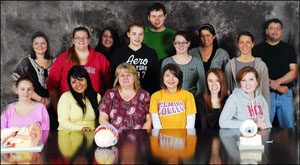
December 3, 2012
Another term comes to an end. If you scroll down this page, you will find a brief description of a few topics covered this term. We have a lot more to cover next term.
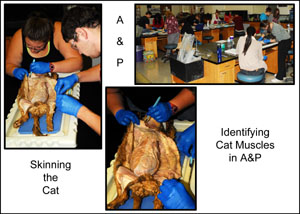
November 12, 2012
Walking, eating and even smiling are activities necessary for a healthy lifestyle. Each of these activities is performed with the use of the muscular system. This system works in conjunction with the nervous system to synchronize movements that are either voluntary (walking) or involuntary (pumping of the heart), to express facial emotions that seem either happy or sad, to fight in times of needed defense or run in the face of overwhelming offense. The muscular system is undeniably an indispensable system. This week we looked at the skeletal muscles (responsible for voluntary motion) of the cat, by first skinning it and peeling away fascia. No easy task, as it is very difficult to separate muscle tissue from the skin and from each other. More on muscles here.

November 5, 2012
The ear is not exclusively used for hearing, as is often assumed. It is a very complex organ, which contains sensory receptors for both hearing and detecting motion (equilibrium). The bottom left inset of the image to the right is a large ear that can easily be divided into 3 regions, the external ear, middle ear and inner ear. The top left inset is an image of the inner ear, which is comprised of the cochlea, semicircular canals, and vestibular apparatus. Each of the regions of the ear have a particular function. Likewise each structure of the inner ear has a particular function. More on the ear here.
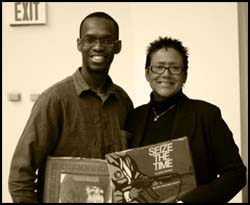
November 1, 2012 (event took place 2/26/2010)
On February 26, 2010, I had the honor and privalege of meeting one of the few remaining original members of the Black Panther Party, Elaine Brown. Those of you who have been keeping close tabs on what I have been doing already know that I have done a Story Traditions with James radio series dedicated to African American literature from Slavery to the Civil Rights Movement. I concluded that series with a discussion on the Black Panther Party. Much to my chagrin, I have yet to post this series on line (it is forthcoming). You can imagine what a personal encounter with someone of her historical and contemporary stature would be like... Film, Read/See More

October 29, 2012
The eyes are often referred to as the windows to the soul. With the help of a magnifying glass or some other means of enlarging the appearance of the eye, one may be saddened to find that there is no soul to be found, rather an iris, a lens, some gelatinous fluid and a retina. We may add the tapetum to that list if one is searching for a soul in a sheep or cat. What is the tapetum you ask? This is the reflective layer that gives a cat's eye the green color often observed at night. That's right! Sorry to dissapoint you folks, but that was exactly what my students and I observed when we dissected the sheep's eye this week, just that, an iris, a lens, some gelatinous fluid and a retina. On the back of the eye we observed a stump, which is better known as the optic nerve. For a brief description of what these structures do click here☻ Eye Anatomy
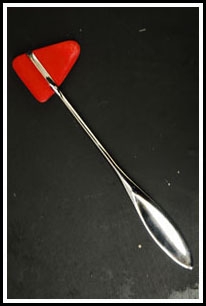
October 22, 2012
The reflex hammer to the right should indicate what this week's lab was about. Yes, you guessed it, lots of jerking, poking, spitting and other actions that would demonstrate the presence or absence of a functioning nervous system. First, a look at the underlying mechanism of the reflex arc:
Some of the reflexes looked at included, of course, the knee-jerk, plantar, salivary, pupillary and the ciliospinal reflexes☻
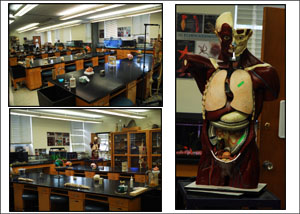
October 8, 2012
Today the students got a chance to show what they have learned via our first lab practical. They were to go around stopping at stations and identifying parts we have gone over during lab seesions. I will keep my fingers crossed as I grade responses☻
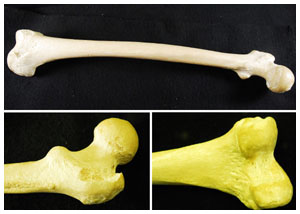
October 1, 2012
This week my students and I concluded our exploration of bones as we looked at the appendicular skeleton. Close attention, however, was given to the pectoral and pelvic girdles along with the bones of the hand and foot.☻
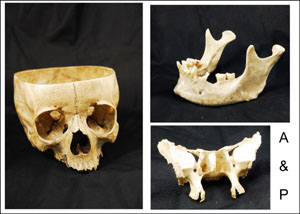
September 24, 2012
Bones are not only used in tandom with muscles to provide the body with locomotion, but as a depot for calcium ions, and a birth place for various cell types. This week we began our exploration of the 206 bones that make up the human body. Of course we started with the skull, whose bones can be further subdivided into the cranium and facial bones. Identifying the cranial bones is not difficult, if one is able to identify the various lobes of the brain. The only difference is that the bones are separated by sutures and not sulci or fissures. The challenge may come in the naming of the facial bones. These include the mandible, maxilla, zygomatic bone, nasal bone, vomer, lacrimal, and palatine. Along with these bones, unique bones like the sphenoid and ethmoid bones also make up the skull. This unique structure has noticeable markings like foramen for blood vessels and nerves to pass to and from the brain. More on bones next week. ☻
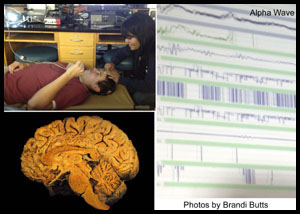
September 17, 2012
One's entire life experience is stored in the brain, the first organ to interact with the environment. This week my students and I looked at the gross anatomy of the human brain to identify key visual structures such as gyri, sulci and fissures. Before looking at interior structures, we shifted our attention to the important outer regions like the frontal lobe, precentral gyrus, central sulcus, postcentral gyrus, parietal lobe, parieto-occipital sulcus, lateral sulcus, occipital lobe, temporal lobe, transverse cerebral fissure, cerebellum, pons, and medulla oblongata. After identifying these regions, we then delved into what each region is responsible for. I won't list the roles of each region here. Instead, I will find a reliable website, which I can reference. My students continued to excavate the brain, as we moved to the interior to identify key internal structures. Once we completed identifying these structures of the human brain, we proceeded to dissect the sheep's brain to find the same structures. Finally, we investigated brain activity via electroencephalography. This technique allowed us to see brain activity in the form of waves. There are four wave types that are of interest, namely alpha, beta, theta and delta waves. However, we only monitored the alpha wave, as it is the easiest to manipulate. The frequency of this wave will increase if the subject is focused on a particular problem. A state of heavy focus and a state of no focus was no problem for one of my students (David) to demonstrate.
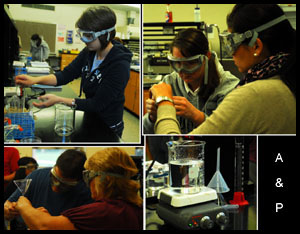
September 10, 2012
This week my students and I got a chance to observe osmosis taking place in a laboratory setting. Dialysis sacs were used as our semi-permeable membrane. Sacs were filled with various types of sugars, all of whose presence were tested for. Surrounding the sacs was distilled water or water filled with sugar. According to the law of osmosis, water will travel from a higher concentration of water to a low concentration of water. It can also be re-phrased in the following way: Water will travel from a low solute concentration to a high solute concentration. Based on that, what do you think happened to the sacs filled with glucose and then immersed in distilled water?
| YNN News |
On July 21, I took some time out to join Johnson City Partners' third anual Carousel Day, an arts and educational event centered around local history. I was a vendor, selling, you might have already guessed, my photography. I have never done something like this before, so it was a surprise to see how many people were interested in purchasing my work. Patrons were especially interested in my landscape/nature photos I had on display. Along with those, I managed to sell portraits using the carousel as a backdrop. Overall this was a wonderful day that brought members of the community out to show some of what Johnson City has to offer. I even made the evening news. Check out the video to your right and a link to the YNN news article here: YNN News' Carousel Day Article.
-O. James

These are the times when flowers come back,
a very few - one or two.
-O. James
© Orin James 2012
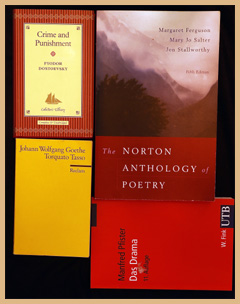
May 24, 2012
It's summer! I have some free time on my hands, approximately 5 weeks. When compared to past years, this is a considerably truncated version of my summer reading experience. This is due to the additional responsibilities I have added to my schedule. Apart from my usual weekly radio show, I have agreed to teach Vertebrate Zoology to graduate students, who hope to become high school biology teachers. Along with that, in between traveling, I can still be found sharpening my photography skills on a daily basis. These activities leave relatively little time for my usual 10-book reading list. As a result, I have narrowed it down to a 4-book reading list. Although the number of books has gotten smaller, make no mistake, the caliber of the texts has gotten larger. This year's list include: Crime and Punishment by Fyodor Mikhailovich Dostoyevsky, Torquato Tasso (German version) by Johann Wolfgang von Goethe, The Norton Anthology of Poetry edited by Margaret Ferguson, et. al., Das Drama (German version) by Manfred Pfister.
After in-depth self deliberation and repeated motion of my eyes from left to right in sync with my right index finger across the shelves of my 600-book home library, I decided on these titles for a number of reasons. First, it was important for me to balance my English readings with German readings. Second, my English readings had to deal with the mind and emotions. Dostoyevsky fulfills the mind requisite, as he worked at a mental clinic and brought his insights of the patients' minds with great detail in narrative form to paper. The emotions requisite is fulfilled with a daily morning dose of poetry from The Norton Anthology of Poetry. Believe it or not, all great science instructors are aware of the need to stay attuned not only to the advances in his/her respective fields, but also to these aspects of the human experience, in order to be an effective and informative teacher. I am no different. Third, The German readings must have been written during German Classicism, or Romanticism, as these are my favorite German literary time periods. Goethes' Torquato Tasso fulfills this. However, I don't want to just read the play, but analyze it as well. So, to accompany Torquato Tasso I have added a text that helps me understand the construction of the German play and it's role in society.
There you have it. Now I will get started! ☻
21.Mai.2012
Meine Meinung war, dass mir Kroatien mit diesen neuen Wörtern mehr Spaß machen wird, deshalb habe ich auch alle auswending gelernt. Ich konnte nicht warten, endlich nach Kroatien zu kommen und dort meine neuen Wörter benutzen. Und dann ist der Tag unserer Abreise gekommen. Die Zugfahrt dauerte ungefähr 5 Stunden...
-O. James
© Orin James 2003
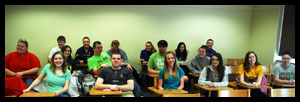
April 9, 2012
Continuing from When Worlds Collide, my students and I delved deeply into the themes of hegemony, gender, determinism, and most of all love. Order and Chaos opened up with a thorough discussion of Jung's idea of the collective unconscious and its archetypes. We got a chance to apply his ideas to the theme of love, as we read The Kreutzer Sonata, Elective Affinities, Cupid and Psyche, Bluebeard along with various fairy tales and selected articles on love. The course concluded with discussions on hegemony (Gramsci), justice (King) gender (Butler), and determinism (Holbach). My students showed what they've learned and how they would apply what they've learned, through their presentations and remarks during discussions. Although there is much more that I can incorporate into my future courses, these students will be well rounded enough to address many of these issues with breath and depth, as they encounter them in their lives.
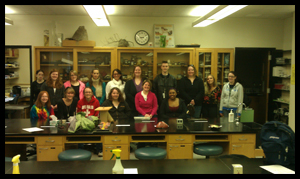
April 9, 2012
Never experienced how quickly time moves until now. Another term comes to an end for both me and my nursing students. They will move on to advanced courses, while all I can do is hope I taught them well.

As the season changes for one which inspires travel, I begin my continual explorations of cultures and worlds, starting with museums in New York City, specifically The Cloisters and The Metropolitan Museum of Art. My trip began on a bright overcast day at 8:45am leaving from Binghamton, NY. At about 10:45am I took a brief food stop at McDonald's, can't quite remember the name of the town, but it was about an hour away from New York City. Although I am from Brooklyn, New York, I never visited either of these museums, so despite the saturated clouds, my excitement was not dampened. Usually when traveling by bus, I observe the surroundings, whether it be landscapes, buildings, farms or simply the greenery. This time, however, my eyes and mind were focused on a narrower field, namely the pages of The Master and Margarita, by Mikhail Bulgakov. The effect of reading this book at that particular time was profound. While I would like to elaborate extensively on this book, I will save an analysis of this text for a later time. For now, suffice it to say that reading this book has prepared my mind for a travel to a past time and space...
March 19, 2012,
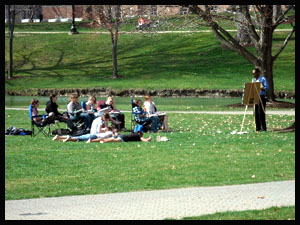
Just couldn't resist the beautiful weather!

March 19, 2012,
This week's Anatomy & Physiology lab section students performed yet another dissection, this time on a pig's uterus. After go over the anatomy of both the male an female reproductive systems, students pulled a piglet or two out of a womb. ☻
March 12, 2012,
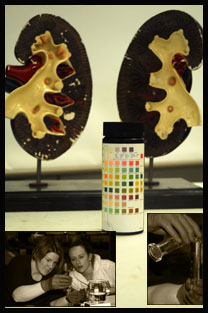
This week's Anatomy & Physiology lab section students got a chance to study the contents of their own urine, the voided product of kidney filtration. Some of the characteristics and substances tested for included pH (usually between 4.5 and 8, average about 6), color (usually clear to pale yellow to amber), specific gravity (usually between 1.001 and 1.030) inorganic substances such as sulfates, phosphates, chlorides, and nitrites. We also tested for organic components like urea, glucose, albumin, ketone bodies, bilirubin, leukocytes bilirubin and urobilinogen. If you are wondering what type information we can gain from such a test, here is a run down:

March 5, 2012,
This week's Anatomy & Physiology lab section students dissected the sheep's kidney, a very simple dissection to see the inside of the organ that is responsible for maintaining electrolyte, acid base, and fluid balances of the blood. This is one of the major homeostatic organs of the body. The dissection revealed several of the important structures of the kidney, which includes the renal cortex, renal medulla, renal pelvis and the ureter. Within those major structures students were able to identify smaller structures like the medullary pyramids, which are triangular regions of the medulla that gives it the striated appearance. Othe substructures include the renal columns, which separate each medullary pyramid from one another. Lastly the calyces, which are fingerlike projections that are found at the renal pelvis. The most important substructure of the kidney, however, is not visible to the naked eye. This structure is known as the nephron and it spans the cortex and medulla. Nephrons, which in some schools is considered a scientific major, and rightfully so, will be discussed during lecture. ☻

February 27, 2012,
This week's Anatomy & Physiology lab section students performed their dissection of the cat. Cajoling these students into conducting the dissection was probably the most difficult task I experieced this semester. Many of my students have one or two cats at home, to which they are emotionally attached, so this was no easy task for them. Nonetheless, the instructor always wins! They carried it out and were able to identify the organs of both the digestive and respiratory systems. Good job students! ☻
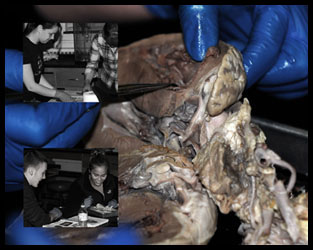
January 23, 2012,
This week's Anatomy & Physiology lab section performed the first dissection of the semester on a pig's heart. After thoroughly discussing the full anatomy of the heart, i.e., everything from the key vessels, chambers, valves, muscles, to the pericardium and everything in between, the students finally got a chance to open the heart for themselves and see first hand the machine that is responsible for pumping oxygen rich blood throughout the body and receiving oxygen poor blood to carry back to the lungs. For those of you who may not know here is a quick description of the function of the heart: Oxygen rich blood is collected from the lungs via the pulmonary veins (2 right and 2 left). These veins will drain the blood into the left atrium. From the left atrium the oxygen rich blood will drain into left ventricle across the mitral valves. The left atrium will contract and force the remaining blood into the left ventricle. Once the left ventricle is completely filled it will contract, shut the mitral valve and force the oxygen rich blood into the aorta across the aortic valve. This blood flow circuitry is referrered to as the “systemic circuit”. For the pathway of oxygen poor blood back to the lungs, feel free to consult one of my students. One of them can provide you with all the information you need to understand the “pulmonary circuit” along with any other info you may want on the heart ☻
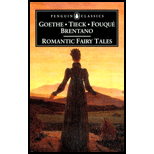
Friedrich de la Motte Fouqué's literary fairy tale, Undine, tells the story of a young water nymph, who is found dripping with water by a fisherman at the door of his hut located in a secluded forest. After happily accepting her into his hut to live and grow with him along with his wife, the married fisherfolk begin to believe Undine is a replacement for their daughter, whom they lost while she was very young. The fisherfolk raise Undine to the best of their ability, but she still lacks a soul, due to her water nymph nature. In order to procure a soul, Undine must marry a mortal human. She meets a mortal knight, Sir Huldbrand von Ringstetten, with whom she falls in love and marries. Once Undine obtains the soul, the reader notices a radical change from her normal demeanor. With the soul, Undine no longer behaves as a childish unconscious nymph, but as a conscious dignified human. Throughout the fairy tale, the author captivates and holds the reader's attention by using various metaphors that allow the reader to understand and analyze Undine. For the remainder of this essay, I will discuss how Undine is portrayed as the quintessential romantic character based on both the author's portrayal of Undine as a water nymph and our understanding of the concept of romanticism. I will also discuss the concept of the soul and how the acquisition of the soul can be interpreted by using some of Freud's psychoanalytical principles...
A new semester has begun and I am excited as are my students. Our course, Order and Chaos, will focus heavily on love and both the order and chaos that seem to be an inevitable requisite for its existance. Other topics include the economy, warfare among other things. See syllabus!
Human Anatomy and Physiology II will continue from part I. Emphasis will be placed on systems, and diseases. I will keep you posted.